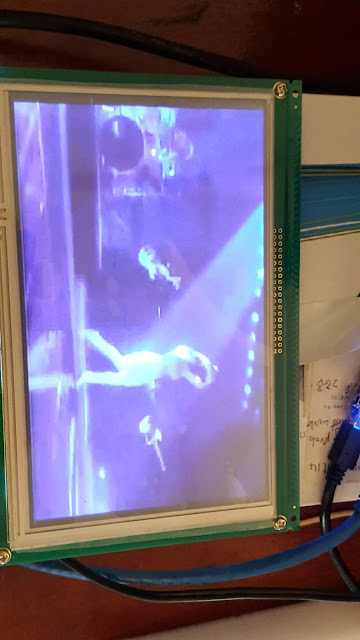 |
| BB View LCD by element14. Note: the FPC cable when correctly inserted may not show printing topside |
The BB View LCD came out about mid-2013, and was one of the earliest LCD panels for the beaglebone. It came with a "cape", ie a beaglebone interface board. I bought mine in December 2014 and could not get it to work. No doubt it worked for many other people: it came with kernel patches and source code for Angstrom, the TI SDK as well as Debian. It is still listed for sale in element14 and Mouser, but recently has become "unavailable".
Currently, there is a worldwide semiconductor shortage, and component leadtimes are now a few months. The temptation to press the BB View 7" LCD back into service became irresistible. I think my problem was I used the kernel patches with a later, 2014 version of Debian while the patches were mid-2013. The beaglebone black could recognize the cape and read its eeprom, but the LCD stayed blank, and the backlights kept blinking in perfect unison with the beaglebone CPU LED.
While no walk in the park, I thought it should possible to get it working. After all I have source code and it should only be a matter of time. And given the pandemic, I have four weeks of lockdown time, to be precise. And hopefully I should learn a little about kernel display drivers too.
First you need a beefy 5V power supply. I used a 5V@3A one. While the average current draw of the BB View LCD is not that high at 240mA, there are regular nasty spikes. I got the occasional CPU crash along with sdcard errors.
 |
| Beaglebone Black Serial Debug Header: Pin 1 is on the right |
You also need to connect to the serial debug port. Any USB serial TTL adapter will do. The pinout is:
Beaglebone Pin Description USB Serial TTL Adapter
1 Gnd Gnd
4 TX RX
5 RX TX
The Beaglebone Black manual specified an FTDI USB adapter, but I used a cheap CH340, which worked well enough. The baud rate is 115200, 8-bits and 1-stop with no hardware flow control.
 |
| FTDI Serial Debug cable. Click on picture for datasheet |
The terminal program I use is minicom, set to 115200 baud, 8-bits, 1-stop and without hardware flow control. If you have the proper FTDI cable, you should use hardware flow control.
dtb_overlay=/lib/firmware/BB-VIEW-LCD7-01-00A0.dtbo
disable_uboot_overlay_video=1
disable_uboot_overlay_audio=1
 |
| Working BB View 7" LCD with Debian Buster 10.3 |
 |
| mplayer |
Debian 10.3 did not seem to recognise the touchscreen, but a little peek at the decompiled dtbo file mentioned a tscadc kernel modue:
There is a wealth of information on the subject, not to mention source code. But there is no schematic, so reading it would be harder. Two weeks later, I could rebuild the latest TI SDK, or even mainline Linux kernel using Linaro, but neither version worked with the BB View LCD. The problem as mentioned earlier was the device tree source code, which I suspect was incomplete for the 7" LCD. The 4.3" version probably worked, but I did not test this.
It was starting to become clear why there was such heavy development over so many years: there is precious little standardization in ARM systems on how to interface to external boards. Each ARM board basically is unique, and back in 2013 this was hardcoded into the kernel source.
At some point each variation was defined in a 'device tree' that was compiled separately from kernel. In practice this simply means a separate sub-directory with its own Makefile all under the same master ARM build.
Eventually, with a little encouragement from Linus Torvalds, the device tree code was shifted to the ARM bootloader, 'Das U-Boot'. This is where the Beaglebone Debug Serial Port comes in handy. Many of the BB View LCD problems are reported only as system console messages, ie to the Debug Serial Port, and may not even show up in the kernel log.
Thus, unlike the manufacturer, Debian admirably maintained support for the BB View. As usual, the documentation became hopelessly out of date, as befits abandonware.
After 2 weeks, Lady Luck took pity on me. I always have a late version of Beaglebone Debian, in this case Debian Buster 10.3 of 2020-04-06. The micro-sdcards are too tiny to label, and I swapped it into the BB View LCD system by mistake. It complained it missed the file BB-VIEW-LCD7-01-00A0.dtbo which just happened to be in the eMMC partition (as /dev/mmcblk1p1). One small change in the boot config file and it worked! Took all of 5 minutes.
 |
| Das Boot: Wolfgang Petersen's 1981 classic |
Hello. I hope you are fine. I am trying to reuse a BB VIEW with BB black and just barely figure out all the complications to get the screen to work. If you managed to get the device working, could you please tell me the steps to follow to make it work? I don't have much programming experience so I would really appreciate non-technical instructions. I thank you in advance for your attention and support.
ReplyDelete